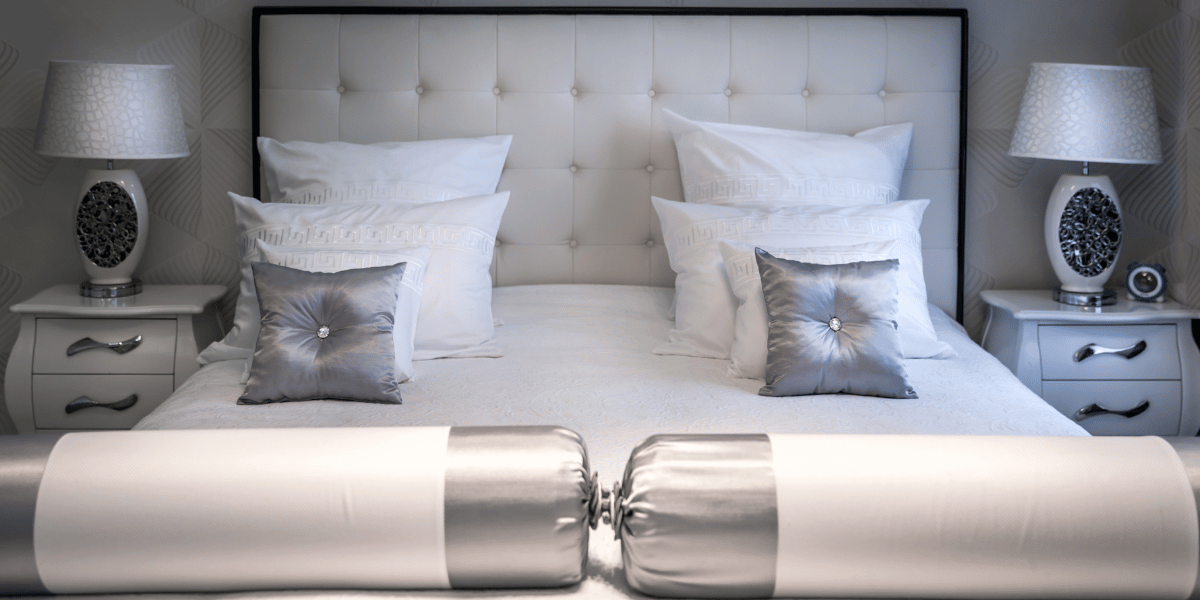STORE LOCATOR

What Can You Expect to Spend on a Mattress?
The price you can expect to pay for a new mattress is impacted by a number of factors. Balancing those factors with your specific personal needs can better help you in making the best possible purchase. In this article, we will provide some items to consider when shopping for a new mattress to help you determine a range when beginning your mattress buying journey.

How Much Does The Average Mattress Cost?
Queen-size mattresses can vary from $250 to over $5,000. These differences arise from the brand name, the physical size, and the material quality. The following sections explore the average prices for mattresses made from various materials, starting with the least expensive:Foam
Foam is the cheapest mattress option available. Manufacturers make these by using layers of foam to cushion and support your body while you sleep. Foam mattresses are popular among sleepers looking to prevent pressure points. The material deforms, spreading their weight, making sleeping in the same position more comfortable for individuals with injuries or achy joints. The back, hips, and neck all benefit. Various foam types are available, including viscoelastic, polyfoam, and gel-infused foam. Polyfoam is the least durable and breaks down rapidly, while gel-infused products promise to keep you cool at night – great if you live in a cold climate. Some foam mattresses also have memory foam. This NASA-developed material is even better at spreading load and contours more precisely to the shape of your body. Manufacturers typically make these mattresses using a standard foam layer at the bottom and a memory foam layer on top. This uppermost layer then comes into contact with your body, providing extra comfort. Here are some price points for conventional queen-size foam mattresses:- Budget: $450
- Premium: $1,000
- Luxury: $1,300
Innerspring
Innerspring mattresses are another common mattress type. These combine sprung coils with polyester fibers and quilted foam. These mattresses are popular because of the support they provide. Sleepers like their robust feel and are less prone to “sinking” into them when they sleep, improving circulation and comfort. Innerspring mattresses come in various firmnesses. The firmest ones let you sleep “on top” of the bed, while the softer ones give you the sensation of sinking into them. Softer innerspring mattresses feel similar to foam but are bouncier when you turn over. These options are better if you want to relieve pressure points but don’t want to pay for memory foam. Moreover, because they are more complex, innerspring mattresses are more expensive than their foam counterparts. Brands must add individual coils by hand, increasing material cost and construction complexity. The cheapest mattresses in this category have fewer coils but tend to be less comfortable, and that’s a problem. More springs better distribute weight and support the body during sleep. Without them, the mattress can feel like it lacks firmness in some areas. Here are some typical price points for conventional innerspring mattresses:- Budget: $600
- Premium: $1,000
- Luxury: $1,200
Latex
Latex is a popular alternative to conventional innerspring and foam mattresses. The material offers the cooling characteristics of the former while offering the pressure point reduction of the latter. You feel supported and comfortable at the same time. The process of manufacturing latex mattresses begins with harvesting latex rubber from trees. After harvesting, producers send raw material for processing, removing impurities and creating latex material. Following vulcanization, operatives pour latex foam into mattress molds before curing. Then, teams construct the final products by adding a fabric covering to produce the finished product. People like latex mattresses because of their comfort and support. Products conform to the body’s shape, like memory foam, relieving pressure points. The material is also highly durable, with a typical lifespan of 10 to 15 years, considerably longer than foam or innerspring mattresses. Latex is popular among sleepers wanting motion isolation. Rolling over won’t disturb your partner because only nearby areas respond to your movements, a consequence of the spring-free design. Finally, mattresses made from 100 percent natural latex are environmentally friendly. Latex rubber is a renewable resource harvested from rubber trees. Of course, latex mattresses have some downsides. The cost is higher, and they weigh significantly more than conventional mattresses. Products may also emit a mild odor that some first-time owners might find unpleasant, and non-synthetic products can be hard to find. Here are some typical price points for latex mattresses:- Budget: $1,200
- Premium: $2,000
- Luxury: $2,500
Hybrid
Finally, we have hybrid mattresses that use coils, memory foam, or latex. The most advanced options come with a hefty price premium. However, they may offer a superior sleeping experience. Hybrid mattresses look similar to conventional sprung mattresses but slightly thicker. Coils account for most of the bulk, with the memory foam or latex comprising the remainder. The most significant advantage of these mattresses is their superior comfort and support. Combining materials lets manufacturers balance both. Mattresses also permit motion isolation. Memory foam or latex elements dampen sleeper movements, reducing the risk of disturbing partners. More edge support is available compared to all-foam alternatives. Manufacturers can reinforce these areas, making the entire surface usable and reducing cramped sensations when sharing with others. Aside from the cost, the main downside of hybrids is the weight. Given the technology and materials they contain, these mattresses are considerably pricier than their conventional counterparts. As such, moving them is harder when moving house or renovating your bedroom. Hybrid mattresses also have the potential for off-gassing. Various layers can have a slight odor when you unpack them that dissipates over time. Lastly, the complex construction of hybrid mattresses makes them less amenable to customization. While you might be able to get a foam mattress cut to your bed’s size, that’s less likely when the manufacturing process is more complicated. Here’s how much you can expect to spend on a hybrid mattress at various price points:- Budget: $1,200
- Premium: $1,500
- Luxury: $3,000
Therapeutic Mattresses
The most expensive mattresses on the market are therapeutic mattresses. These provide additional comfort, support, and functionality to address specific health or medical issues. You mostly find them in hospital settings and rehabilitation centers, but some products are also available for the home. The primary function of these mattresses is pressure relief. Materials redistribute force away from some areas of the body and onto others, which is helpful for immobile or bedridden individuals. Mattresses typically use hybrid construction, including memory foam, latex, and other forms of foam with pressure-relieving properties. Mattresses may also be adjustable. This feature makes them suitable for mechanical beds or sitting at a particular angle to eat food or receive medical treatment. Finally, therapeutic mattresses may have antimicrobial or hygiene features. Products may contain substances that inhibit the growth of harmful organisms, protecting you against infection if your immune system is weak. Mattresses often comply with health and safety regulations, reducing the risk of harm. Given the extensive onboard technologies, most therapeutic mattresses are expensive. Expect to pay $5,000 or more for a quality product with all the requisite features.What Determines The Price Of A Mattress?
How much a mattress costs depends on various factors. The previous section provided some insight, but we go into more detail here.
Size
First up, size can significantly impact the price of a mattress. Holding everything else equal, king-size mattresses cost more than those for single beds. The price is higher for an obvious reason: manufacturers must use more materials. Double mattresses may also have more complex constructions to help prevent motion transfer.Features
Features can also play a significant role in mattress pricing. The more bells and whistles a mattress has, the more you would expect to pay. For example, some mattresses have support zones targeting specific areas of the body, such as the lumbar spine. Other mattresses are adjustable. For example, therapeutic products may need to bend at various points, depending on how the bed supporting them moves. Temperature regulation is another feature that affects price. Some mattresses have cooling layers that let air circulate throughout the night, reducing sweating and discomfort during sleep. These are more costly to manufacture, pushing up the price. High-weight capacity is also something that pushes up the price. These mattresses are for individuals with higher body weights, sometimes called “bariatric options,” and feature reinforcements. Finally, you can expect to pay more for mattresses with vibration or massage features. These products contain motors and additional massage equipment to help you feel comfortable lying down. Warranties Warranties also affect the price of mattresses. The more extended the factory warranty, the higher the price you will pay to cover the vendor’s risks. Warranties can vary significantly from one vendor to another. More affordable options are less generous, while premium brands may guarantee comfort for up to ten years.Materials
Naturally, materials are another factor that determines mattress pricing. The rarer the materials, the more you will pay. Foam is the cheapest because manufacturers can produce it in bulk, cut it, and cover it with fabric to make a mattress. Innerspring versions are more complicated but still surprisingly affordable despite the difficulties in arranging all the springs. Mattresses containing synthetic materials are the most costly. These often require proprietary processes that only one brand can access, pushing the price up.What Quality Can You Expect At Various Mattress Price Points?
When it comes to mattress pricing, the materials don’t matter. What counts is the overall quality of the experience. This section describes various mattress quality levels and what you can expect from each.Bargain Mattresses - $250 to $500
Bargain mattresses are the most cost effective of all. Most products in this category are innerspring or all-foam. Manufacturers reduce costs by reducing quality. Problems with cheaper mattresses include less responsive and supportive materials, damage-prone elements, and short lifespans. Many ultra-cheap products only last five years before you need to replace them. Other problems can include:- Lack of customer support
- Minimal motion isolation
- Noisy springs that creak whenever you move
- Lack of edge support, reducing usable area
- Dangerous off-gassing from suspect materials
- Less concern for the environment embodied in the manufacturing process
Budget Mattresses: $500 to $1,000
Budget mattresses are usually made of innerspring or memory foam, making them economical. Some may last up to a decade with the proper care. Fabrics and materials will be basic and cost-effective. Innerspring systems are unlikely to be proprietary. Construction standards will be simple, and you will have a choice of standard firmness options. Custom designs will not be available. However, mattresses should still be fit for purpose despite these limitations. Shorter warranty periods and simplified aesthetics let you access substantially lower prices.Premium Mattresses: $1,000 to $4,000
Premium mattresses are considerably more expensive and can be up to eight times the price of their budget counterparts. However, the additional expense is worth it. For example, premium mattresses give you:- Higher-quality materials, such as high-density memory foam, natural latex, and advanced innerspring
- Exclusive branding from well-known manufacturers in the industry
- Eco-friendly materials made sustainably that won’t compromise your health
- Digital mattress features, such as sleep tracking, temperature control, and smart home device compatibility
- Advanced support technologies, including zoned support for hips, neck, etc.
- Extended warranty periods reflect the manufacturer’s confidence in the quality of the materials
- More attractive aesthetics
- Reinforced edge support to make more of the mattress’s surface area usable
- Improved motion isolation, preventing you from waking your partner when you move
- Better cooling technologies, such as breathable covers and gel-infused foams
Luxury Mattresses: $4,000+
Finally, luxury mattresses command the highest price tags. These take the features of premium mattresses and add them, offering extra cushioning and advanced materials. Many luxury mattress manufacturers claim their products offer therapeutic benefits, such as pain relief and posture correction. Hypoallergenic materials may also make them more suitable for individuals with allergies. Other features might include:- Exquisite materials, such as cashmere, silk, high-grade wool, and natural fibers
- Handcrafted elements and artistry
- Design collaborations with exclusive designers
- Rare or unique materials such as horsehair or cashmere blends
- Artisanal finishes, such as patterns on the mattress cover
- Pillow-top designs for a more lavish feel
- Adjustable firmness and support features
- Premium warranties and service options
How To Save Money When Buying Mattresses
Spending thousands of dollars on a mattress might seem excessive if you have other expenses you need to meet. Fortunately, there are ways to save money while still getting a great product.-
Shop Online During Sales
-
Compare Online Prices
-
Negotiate The Price
-
Get Financing
-
Buy A Floor Model
-
Buy A Mattress Protector
-
Buy An Older Model
-
Read Reviews
